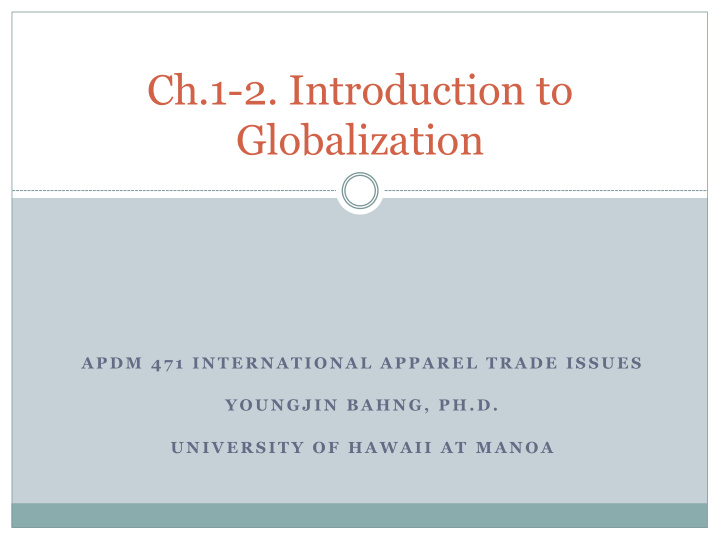



Ch.1-2. Introduction to Globalization A P D M 4 7 1 I N T E R N A T I O N A L A P P A R E L T R A D E I S S U E S Y O U N G J I N B A H N G , P H . D . U N I V E R S I T Y O F H A W A I I A T M A N O A
Measuring Levels of Development 2 The World Bank and United Nations use the term least developed to describe the world’s poorest countries Terms First World , Second World , Third World indicate differences in levels of development This text defines countries’ levels of well -being as least developed , newly developing , developing , and developed countries
Measuring Levels of Development 3 Gross national product (GNP) Gross national product (GNP) per capita Gross domestic product (GDP) Gross domestic product (GDP) per capita Purchasing Power Parity (PPP)
Measuring Levels of Development 4 Per capita Gross national product (GNP) Gross national product (GNP) per capita Gross domestic product (GDP) Gross domestic product (GDP) per capita
Table 1.2, cont.
Developed Countries 8 Shifted emphasis from producing textiles and apparel to consuming them Product development encompasses the design and engineering of products to be serviceable, producible, salable, and profitable (Glock & Kunz, 1995)
Developing Countries 9 Significantly improved overall economic condition beyond those of newly developing countries Embraced the production of textile and apparel products as a way to compete in the global marketplace No longer the lowest-cost labor sources
Newly Developing Countries 10 Nations whose overall economic conditions fall well below the world average in GDP per capita and other measures Apparel production continues to be the vehicle that provides employment where unemployment and poverty rates are high and wages are low
Least-Developed Countries 11 Rank the lowest in measures of economic well- being Often suffer from governmental exploitation, ongoing tribal wars, lack of education, and traditions inhibiting change
Organization and Operation of the Textile Complex 12 Horizontal integration is change brought about through mergers and takeovers among firms that perform similar actions Vertical integration occurs when firms that perform different stages in the planning, design, production, and distribution of products join to form one larger business
Figure 1.6: Regions of the world in which global retailers are based
Summary 14 Ways to view and analyze the operations of global production and distribution include economic and business, political and governmental, and sociological and labor perspectives Countries around the world can be viewed as newly developing, developing, or developed, based on the trade balance of each in relation to textiles and apparel and gross domestic product per capita The textile complex incorporates firms around the world into supply chains to accomplish textile manufacturing, apparel manufacturing, retailing, and consumption of textile products
Recommend
More recommend